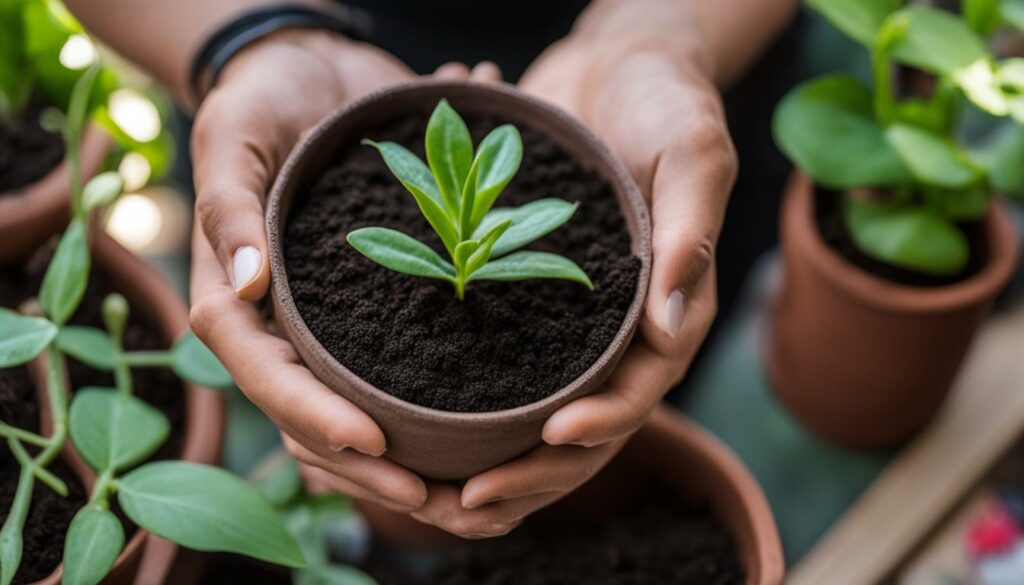Welcome to our comprehensive Shark Tooth Plant Care Guide! If you’re a plant enthusiast looking for tips on caring for shark tooth plants, you’ve come to the right place. Whether you’re a seasoned plant parent or just starting out, this essential care guide will provide you with all the knowledge you need to keep your plants healthy and thriving.
Also known as the crassula red pagoda, these unique succulents with triangular green leaves and red tips are native to South Africa. With proper care, they can grow up to 8 inches long and produce beautiful white flowers in the summer.
In this care guide, we’ll cover everything from watering tips to providing adequate light, choosing the right soil and pot, and more. So let’s dive in and discover the best practices for caring for your shark tooth plants!
Shark Tooth Plant Watering Tips
Proper watering is essential for the health and longevity of your shark tooth plants. Follow these tips to ensure that you keep your plants happy and prevent root rot:
- Water once a week: Shark tooth plants should be watered once a week to maintain the right balance of moisture. Overwatering can lead to root rot and other fungal diseases, so it’s crucial not to water too frequently.
- Allow the soil to dry out: Before watering again, make sure that the soil has completely dried out. This will help prevent moisture-related issues and ensure the optimal growth of your plants.
- Adjust watering schedule: During the winter months when the plant is dormant, reduce the watering frequency to every three to four weeks. In the summer, when the plant is actively growing, you may need to water more often if the soil appears dry.
Remember, finding the right balance is key. Underwatering can lead to dry and wrinkled leaves, while overwatering can cause root rot. Observing the condition of the soil and adjusting your watering schedule accordingly will help keep your shark tooth plants healthy and thriving.
Preventing Root Rot in Shark Tooth Plants
Root rot is a common issue that can affect succulent plants, including shark tooth plants. It occurs when the roots are constantly exposed to excess moisture, leading to fungal diseases. Here are some additional tips to prevent root rot:
- Use well-draining soil: Choose a soil specifically formulated for succulents, like crassula red pagoda. These soils promote better drainage and prevent water from accumulating around the roots.
- Ensure proper drainage: Plant your shark tooth plants in pots with drainage holes to allow excess water to escape. This will help prevent water from pooling at the bottom of the pot and saturating the roots.
- Avoid overwatering: Stick to a consistent watering schedule and resist the temptation to water more frequently than necessary.
By following these watering tips and taking precautions to prevent root rot, you can ensure the health and vitality of your shark tooth plants.
Table: Shark Tooth Plant Watering Schedule
| Season | Watering Frequency |
|---|---|
| Spring | Once a week |
| Summer | Once or twice a week if soil appears dry |
| Fall | Once a week |
| Winter | Every three to four weeks |
Follow these watering tips and schedule to keep your shark tooth plants thriving. Remember, finding the right balance is crucial to prevent overwatering and root rot. With proper care, your shark tooth plants will reward you with their unique beauty and vibrant colors.
Providing Adequate Light for Your Shark Tooth Plant
One of the essential aspects of caring for shark tooth plants is providing them with adequate light. These unique succulents thrive when exposed to about 6 hours of sunlight or bright, indirect light each day. The sunlight is crucial for their growth and helps develop their vibrant colors. If the plant doesn’t receive enough light, it may become pale and not showcase its true colors.
When growing shark tooth plants indoors, it’s important to place them in a spot that receives at least 6 hours of sunlight per day. This can be achieved by positioning them near a sunny window or using artificial grow lights. By providing the necessary light, you can prevent a common problem known as etiolation, which is the stretching and elongation of the plant due to insufficient light.
However, it’s important to strike a balance, as too much direct sunlight can harm the plant. It can lead to sunburn and cause the leaves to dry out. To protect the plant from excessive sun exposure, partial shade should be provided, especially during the hottest hours of the day. This will ensure that your shark tooth plant receives the right amount of light without the risk of sun damage.
Table: Comparing Light Requirements for Different Succulent Species
| Succulent Species | Light Requirements |
|---|---|
| Echeveria | Full sun to bright, indirect light |
| Haworthia | Bright, indirect light to partial shade |
| Aloe Vera | Full sun to bright, indirect light |
| Shark Tooth Plant (Crassula Red Pagoda) | About 6 hours of sunlight or bright, indirect light |
Remember to observe your shark tooth plant closely and adjust its lighting conditions accordingly. If you notice signs of pale or elongated growth, it may indicate a need for more light. On the other hand, if the leaves start to turn yellow or brown, it could be a sign of sunburn, and you should provide more shade. By striking the right balance between light and shade, your shark tooth plant will thrive and display its unique beauty.
Choosing the Right Soil and Pot for Your Shark Tooth Plant
When it comes to caring for your shark tooth plants, choosing the right soil and pot is essential for their overall health and well-being. These succulents have specific requirements, and providing them with the proper growing conditions will help them thrive. Here are some tips on selecting the right soil and pot for your shark tooth plants:
Choosing Soil for Shark Tooth Plants
Shark tooth plants require well-draining soil to prevent the risk of root rot. It’s best to use a soil specifically formulated for crassula red pagoda, as it contains fast-draining ingredients like sand and perlite. This type of soil allows water to flow through quickly, preventing excess moisture from accumulating around the roots. Additionally, a specialized soil mix provides essential nutrients that promote healthy growth.
Pot Size for Shark Tooth Plants
When it comes to selecting a pot for your shark tooth plant, it’s important to choose the appropriate size. The pot should allow enough space for the plant’s roots to grow comfortably. If the pot is too small, the roots can become crowded and hinder the plant’s growth. On the other hand, if the pot is too large, it can retain excess moisture, leading to root rot. Consider the size of your plant and choose a pot that provides a snug fit without restricting growth.
Well-Draining Soil for Shark Tooth Plants
In addition to using well-draining soil, it’s crucial to ensure that the pot you choose has adequate drainage. A pot with a drainage hole allows excess water to escape, preventing waterlogged soil and root rot. Before planting your shark tooth plant, check that the pot has proper drainage and consider adding a layer of gravel or small stones at the bottom to facilitate water flow.
By selecting the right soil and pot for your shark tooth plants, you are creating an optimal environment for their growth and development. Remember to choose well-draining soil, select an appropriate pot size, and ensure proper drainage to prevent water accumulation. These small steps can make a big difference in the overall health and happiness of your shark tooth plants.

Conclusion
In conclusion, caring for shark tooth plants, also known as crassula red pagoda, is a rewarding and simple task. By following the essential care guide provided, you can ensure the happiness and flourishing of these unique and beautiful succulents.
Remember to choose the right soil and pot for your shark tooth plant, opting for well-draining soil that prevents root rot and using a pot with a drainage hole. This will provide the perfect environment for your plant’s growth.
Additionally, make sure to provide adequate light for your shark tooth plant, allowing it to receive about 6 hours of sunlight or bright, indirect light each day. This will enhance its vibrant colors and prevent etiolation.
Lastly, be mindful of your watering schedule, ensuring you water once a week to avoid both overwatering and underwatering. This will help prevent root rot and keep your shark tooth plant healthy and thriving.
FAQ
How often should I water my shark tooth plant?
Shark tooth plants should be watered once a week to prevent root rot. During winter, watering can be reduced to every three to four weeks, and in the summer, it may need to be increased to once or twice a week if the soil appears dry.
How much sunlight do shark tooth plants need?
Shark tooth plants require about 6 hours of sunlight or bright, indirect light each day. This is important for their growth and for developing their unique and vibrant colors. If the plant doesn’t receive enough sunlight, it may become pale and not show its true colors.
What kind of soil should I use for my shark tooth plant?
Shark tooth plants require well-draining soil to prevent root rot. A soil specifically formulated for crassula red pagoda is recommended, as it contains fast-draining ingredients like sand and perlite. This type of soil also provides essential nutrients to help the plant grow healthy and strong.
What size pot should I use for my shark tooth plant?
When choosing a pot for your shark tooth plant, it should be the appropriate size for the plant, with a drainage hole to allow excess water to escape. Using a succulent pot with a unique design can also enhance the overall appearance of the plant.





